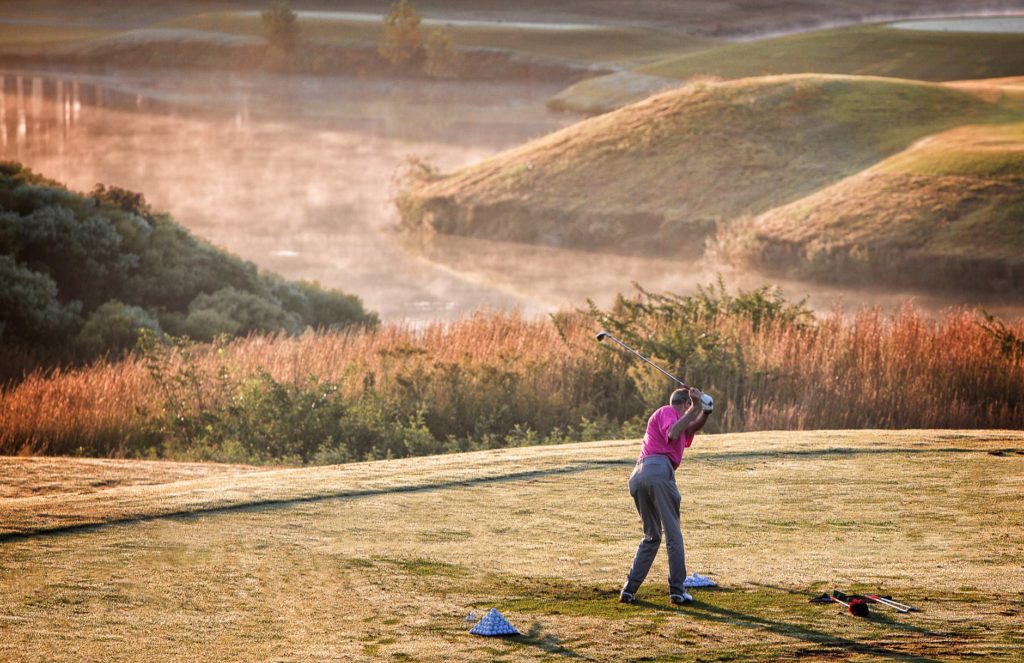Are you thinking about learning how to play golf? Golf is a sport that you might have an equal love, hate relationship with. It can be the most rewarding, while simultaneously being the most frustrating sport. It can also feel a little overwhelming because there's so much to learn. That’s why we are just going to focus on the basics with this guide for beginner golfers. No one becomes a good golfer right away; even for the pros, it takes years of work. Don't place lofty expectations on yourself and enjoy the game.

Aviara Golf Course
Golf Terms
You can check out the USGA Player's Handbook for a complete list of terms and rules. In the meantime, you can find a list of common terms here.
Time To Hit The Golf Range
If you've never hit a ball before, you should go to the driving range immediately and whack some balls. You will quickly realize how hard it is to hit that tiny white ball straight. After you had your fix of Happy Gilmore swings, you will want to take lessons ASAP! The worst thing to do as a beginner is to develop bad habits. In golf, your form and swing is everything. Training bad habits into your game will only hinder your ability to have a good time on the course. Make sure you take a lesson or two from a USGA professional. You can check your local driving range or golf course to book a private lesson with their head pro!

Practice, Practice, Practice
After your first lesson, you will have to head back to the range and hit as many balls as possible. Developing a good swing is a process, but one way to help ease the process is by sticking to your shorter irons. A Pitching Wedge or 9-Iron are great clubs to help develop the swings. Try taking half swings at first, then work your way up to a full swing. Most of the time, you end up taking half swings with your wedges anyway.
Long Game
Golf can be broken down into three areas of focus. The long game, mid-game, and the short game. The long game pertains to your first shot off the tee or anything over 170 yards. When you focus on your long game, you are working on hitting the ball with your woods or long irons. Most people think distance is the most important factor here, but it really comes down to control. For a while, I always preferred hitting my 7 wood off the tee, because I knew I could hit the ball straight with that club. An extra 50 yards off the tee shot doesn’t mean anything if it’s in the other fairway behind a tree.

Mid Game
The mid-game has to do with your mid-irons and any shot between 120- 170 yards. These shots will be your approach shots into the green, 2nd, or 3rd shot. We suggest working on the iron that you can hit 140-150 yards. This distance from the hole is very common on par-4’s for most people and very helpful to work on hitting proficiently with one iron. As you get better you can start to work in other irons. Watch Tin Cup and you will understand. It’s all about the 7-iron.

Short Game
When we talk about the short games, we are talking about any shot under 100 yards. The most important aspect of your short game is putting. Working on your putting will always shave strokes off your score. The best part is that anyone can go to a public course and spend some time on the practice green. Take four balls and start with 3-foot putts. Other aspects of the short game that can easily be worked on are chipping and bunker shots. You may want to check beforehand, but not all courses have practice chipping areas or practice bunkers.

Practicing Putting Takes Off Strokes
Ways For Beginner Golfers To Improve
We suggest you practice your short game. You just need 2 clubs, a putter, and your sand wedge. Plus some balls. If a club doesn’t have a separate chipping area, go in the afternoon when the course is not busy and practice chipping on the practice green. Courses will offer cheaper twilight rates as well after 3 pm. The most important thing to remember from this guide for beginner golfers is that honing your short game is the best thing you can do. Even after the worst tee shot, sinking a 20 ft. putt will always make you feel like Tiger Woods winning the Masters.
Golf Courses
Before you hit the links, you should know that golf courses are divided into two types: Private and Public. Private clubs require a yearly membership and are generally very expensive. The only way you can play these courses is by becoming a member or a member’s guest. Public clubs are open to everyone but can differ greatly in upkeep and quality. All courses will have a dress code and it’s always good to assume the club is strict about it. A standard rule of thumb is to wear slacks or shorts and a collared polo shirt. Courses will always be more crowded on weekend mornings so a good time for beginners is in the afternoon or during the week. Always be aware of your speed of play and allow faster groups to play through. This ties into golf etiquette which is the game’s code of conduct.

Golf Etiquette For Beginner Golfers
Golf is one of the oldest sports in the world that still honors the game’s class and etiquette. This is an essential trait to develop for when you get paired up with golfers you don’t know. Here are some of the common rules of etiquette to know.
- Let the player farthest away from the pin hit first.
- Let the winner of the previous hole tee off first at the next tee.
- Abide by cart rules and stay on the path as much as possible.
- Turn in every score for handicap purposes.
- Rest the flagstick on the fringe of the green.
- Wait to hit until the group in front of you is well out of range
- Play at a reasonable pace—about 2 hours for nine holes.
- Repair ball marks, replace divots and rake bunkers.
- Follow the rules of the USGA.
- Tip the bag boys at the end of the round for cleaning your clubs.
- Don’t move or talk while someone in your group is hitting the ball
- Don’t stand directly behind someone during their swing (this is beneficial for both parties involved)
- Don’t ask your opponent what club he hit in tournaments, you will be penalized!
- Don’t walk across the line of another player’s putt.

19th Hole
Finally, we'd like to wish you well on your journey. Yes, golf is a journey. The biggest challenge is to not give up. One of the most important things to remember from this guide for beginner golfers is the fact that this game will always be a challenge, no matter how good you are. Even the best player in the world can have a horrible day.
Don't be discouraged. Let it drive you even further to become a better player. The time you spend on the golf course can be a relaxing way to escape the stresses of life while spending quality time with friends and family. Now you just have to worry about the stresses of an island green surrounded by water, but that's the fun type of stress. Always order a strong Arnold Palmer on the 19th Hole - another term for the clubhouse.



